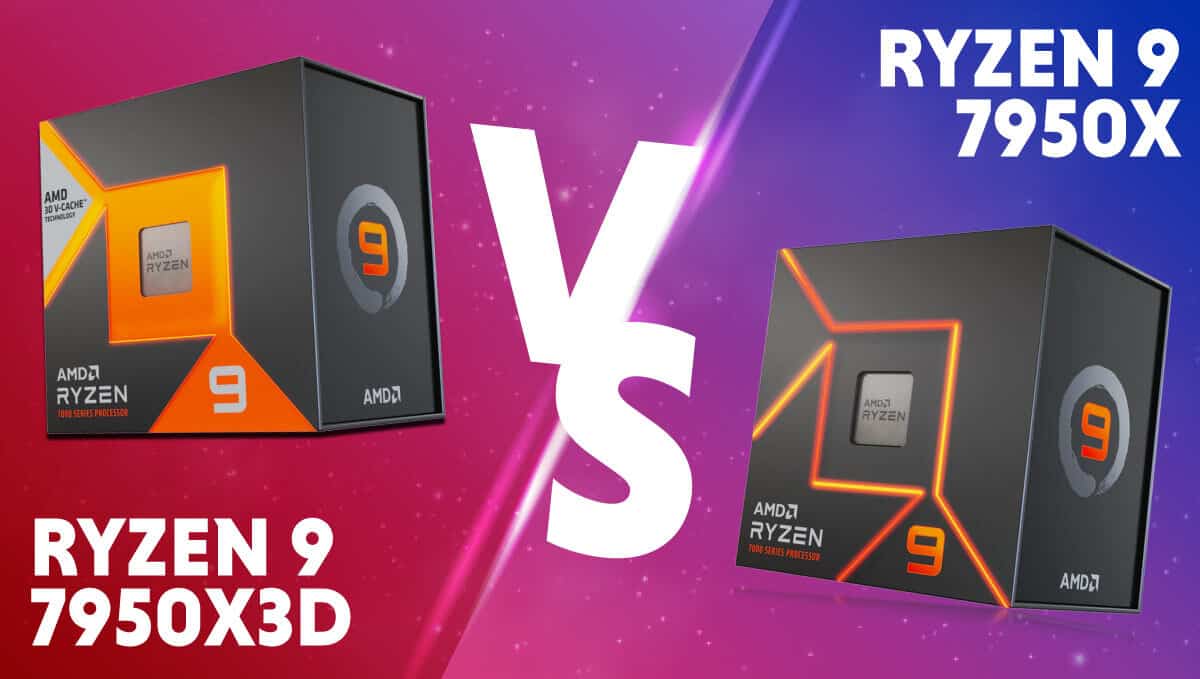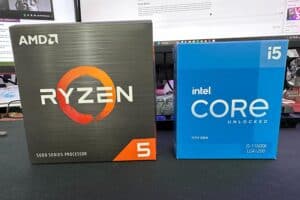AMD Ryzen 9 7950X3D vs Ryzen 9 7950X
AMD Ryzen 9 7950X3D vs Ryzen 9 7950X: Which is better?

WePC is reader-supported. When you buy through links on our site, we may earn an affiliate commission. Prices subject to change. Learn more
AMD introduced us to three new Ryzen 7000 X3D CPUs at CES 2023, promising that they will bring performance as we’ve never seen before. Today, however, we’re interested in the Ryzen 9 7950X3D and how it stacks up against the 7950X. This is AMD Ryzen 9 7950X3D vs Ryzen 9 7950X.
Now read: AMD Ryzen 9 7950X3D vs 13900KS
Today we will analyze the specifications of each CPU to determine which is the best, and for what use case. We will use our knowledge of how CPUs work since the 7950X3D is unfortunately unreleased. We expect the see the X3D CPUs sometime in February 2023. We’ll update you as soon as we know more on the matter.
Before we jump into it, however, we need to list the specifications of each CPU. So, without further delay let’s get into the specifications.
Update: AMD has announced the official release date of the Ryzen 9 7950X. It will be on February 28th, 2023.
AMD Ryzen 9 7950X3D vs Ryzen 9 7950X: Specifications
Here we will list the specifications of each of the Ryzen 9 CPUs we’re looking at today.
Ryzen 9 7950X3D
-
- Architecture: Zen 4
-
- Core count: 16
-
- Thread count: 32
- Base clock frequency: 4.2GHz
-
- Boost clock frequency: 5.7GHz
-
- L3 cache: 144MB
-
- TDP 120W
- iGPU: RDNA 2
The 7950X3D is a monster of a CPU. With 16 cores and 32 threads, it’s hard to ignore this CPU’s value to content creators and workstation users alike. But how will the reduced core speed hold up against the original 7950X?
Ryzen 9 7950X
- Architecture: Zen 4
- Core count: 16
- Thread count: 32
- Base clock frequency: 4.5 GHz
- Boost clock frequency: 5.7 GHz
- L3 cache: 80MB
- TDP: 170W
- iGPU: RDNA 2
The Ryzen 9 7950X is the most powerful AMD CPU in existence, bar the Threadrippers of course, This 16-core 32-thread behemoth can chew through absolutely any CPU load you throw at it. Completely dominating the CPUs of the last generation.
With all that out of the way, it’s time to compare the specifications.
AMD Ryzen 9 7950X3D vs Ryzen 9 7950X: Specification comparison
For the sake of ease, we’re only going to be outlining the things that are different here. Else we fear this article could get very long. Here is what’s different about the two CPUs, and why that affects performance.
CPU clock speed
Both CPUs have the same boosted clock speed, however, the 7950X3D has a lower base clock speed. This means that the 7950X3D is more power efficient in the low end, but will perform worse in the low end. It will also take slightly longer to reach peak speeds.
CPU clock speed refers to the rate at which a CPU can execute instructions. A higher clock speed means that the CPU can execute more instructions per second, which can result in faster performance.
The CPU instruction cycle consists of three main actions, these are; Fetch, decode, and execute. The faster a CPU can complete this cycle, the better. A CPU clock speed is a measure of how many of these cycles a CPU can complete per second.
However, some workloads are more sensitive to clock speed than others; for example, a task that involves a lot of single-threaded calculations will benefit more from a higher clock speed than a task that is heavily multithreaded.
CPU cache
The 7950X3D has a much higher cache capacity than the 7950X, giving it an edge in gaming performance especially.
A CPU cache is a small amount of high-speed memory that is built into a CPU to store frequently-used data. Having more CPU cache can significantly improve CPU performance because it reduces the number of times the CPU has to access the slower main memory to retrieve data.
When a CPU needs to access data, it first checks the cache to see if the data is already stored there. If the data is in the cache, the CPU can access it much faster than it could if it had to go to the main memory. If the data is not in the cache, the CPU has to fetch it from the main memory, which is a slower process. When the CPU fetches data from the main memory, it also stores a copy of that data in the cache, so it will be easily accessible the next time the CPU needs it.
The more cache a CPU has, the more data it can store, which means it has to access main memory less often. This can result in a significant improvement in performance, especially for workloads that involve a lot of data access. Additionally, having a larger cache allows the CPU to store more data that is likely to be needed in the future, which also helps to improve performance.
CPU TDP
The Ryzen 9 7950X3D has a lower TDP than the 7950X making it more efficient to run and cool.
TDP is a measure of the maximum amount of heat that a CPU is designed to dissipate. It is typically measured in watts and is used to help determine the cooling requirements for a system.
A higher TDP means that the CPU generates more heat and requires more cooling. This can affect the overall performance and stability of the system, as well as the size and cost of the cooling solution. A CPU with a high TDP will typically require a larger and more expensive cooling solution, such as a larger heatsink or a liquid cooling system.
A lower TDP, on the other hand, means that the CPU generates less heat and requires less cooling. This can make the system more energy-efficient and can also help to reduce the size and cost of the cooling solution. A CPU with a low TDP will typically be able to use a smaller and less expensive cooling solution, such as a smaller heatsink or a simple air cooling system.
CPU Socket
Thankfully, both of the CPUs on today’s list belong to the same CPU socket. This makes life a little easier and you don’t have to go and get a completely different motherboard if you opt for either of these CPus over the other.
Both the 7950X3D and the 7950X belong to the same AM5 CPU socket, supported by the AMD 700 series motherboards released last year. LGA 1718 has 18 pins more than the socket LGA 1700 socket from Intel, allowing AMD a little more freedom when it comes to feature mapping. However, just because AMD has moved to the LGA socket architecture does not mean it will fit any motherboard, so make sure you only snag the AM5 motherboard for AM5 CPUs.
AMD Ryzen 9 7950X3D vs Ryzen 9 7950X: Price
It’s impossible to determine the value of the 7950X3D as we don’t have any official pricing for it. But if it costs anywhere near the 7950X did when it launched it should be a decent value for money. Although we’d like to see it lowered like the rest of the Ryzen 7000 series.
or will AMD use the release of the X3D line-up to re-inflate the price of the 7000 X series CPUs? Only time will tell. We only have to wait until February.
AMD Ryzen 9 7950X3D vs Ryzen 9 7950X: Conclusion
It looks like the Ryzen 9 7950X3D and the 7950X may be more evenly matched than the 5800X3D and 5800X was. It looks like AMD may have solved the cache issue that forced the lowering of the boost clock speed.
Please note that the X3D CPU is designed for gaming and not specifically workstation tasks, however, the lack of speed restrictions might make the X3D more of a contender against the 7950X in multithreaded workloads.
We will have to wait until we get our hands on it to find out.
both of the CPUs here are incredibly strong, however, the X3D CPU is more centered toward pure gaming. So if that is the bulk of your PC’s workload, we would suggest the X3D CPU when it is released in February 2023.










